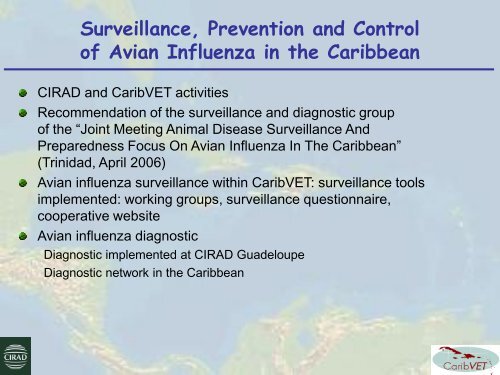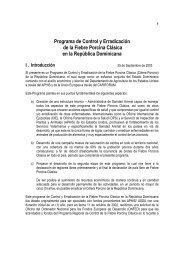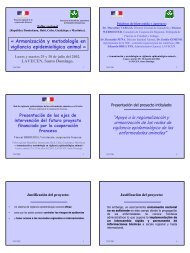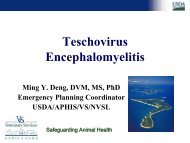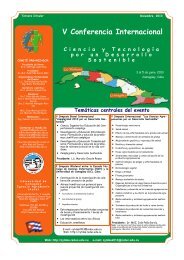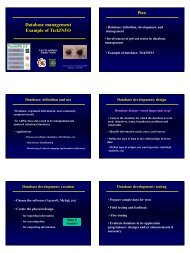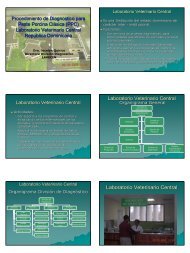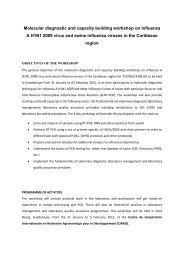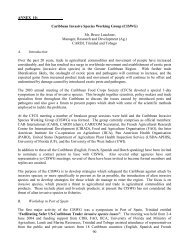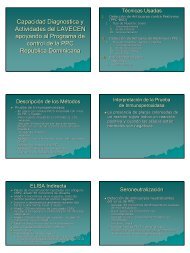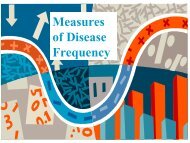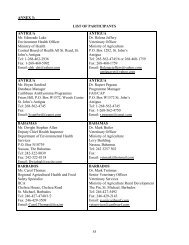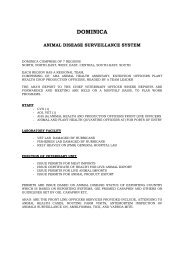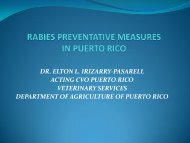CaribVET activities
CaribVET activities
CaribVET activities
You also want an ePaper? Increase the reach of your titles
YUMPU automatically turns print PDFs into web optimized ePapers that Google loves.
Surveillance, Prevention and Control<br />
of Avian Influenza in the Caribbean<br />
CIRAD and <strong>CaribVET</strong> <strong>activities</strong><br />
Recommendation of the surveillance and diagnostic group<br />
of the “Joint Meeting Animal Disease Surveillance And<br />
Preparedness Focus On Avian Influenza In The Caribbean”<br />
(Trinidad, April 2006)<br />
Avian influenza surveillance within <strong>CaribVET</strong>: surveillance tools<br />
implemented: working groups, surveillance questionnaire,<br />
cooperative website<br />
Avian influenza diagnostic<br />
Diagnostic implemented at CIRAD Guadeloupe<br />
Diagnostic network in the Caribbean
Surveillance, Prevention and Control<br />
of Avian Influenza - CIRAD<br />
CIRAD and <strong>CaribVET</strong> <strong>activities</strong> and organization<br />
Recommendation of the surveillance and diagnostic group<br />
of the “Joint Meeting Animal Disease Surveillance And<br />
Preparedness Focus On Avian Influenza In The Caribbean”<br />
(Trinidad, April 2006)<br />
Avian influenza surveillance within <strong>CaribVET</strong>: surveillance tools<br />
implemented: working groups, surveillance questionnaire,<br />
cooperative website<br />
Avian influenza diagnostic<br />
Diagnostic implemented at CIRAD Guadeloupe<br />
Diagnostic network in the Caribbean
CIRAD,<br />
Guadeloupe<br />
CIRAD International Research Centre in Agricultural for Development<br />
Research, development, training<br />
Veterinary medicine and public health<br />
CIRAD Guadeloupe<br />
‣ Research unit “Control of exotic and emerging animal diseases”<br />
‣ 3 researchers, 5 lab technicians, 2 animal technicians, 1 secretary<br />
1 webmaster + 4 students a year (Vet, Master, PhD)<br />
‣ Laboratory = Platform for biotechnology<br />
‣ 300 m 2 : cellular biology (L2 security), molecular biology<br />
(real time PCR, micro-array) serology, parasitology, immunology<br />
‣ Animal house (100 goats, rabbits) + surgery<br />
‣ Biological resources centre
CIRAD Guadeloupe <strong>activities</strong><br />
Support to development within the network<br />
National or international mandates (references)<br />
Research <strong>activities</strong><br />
(vaccine, diagnosis,<br />
molecular epidemiology)<br />
on ticks & tick<br />
transmitted diseases<br />
Widening set of<br />
themes with<br />
diseases with<br />
research objectives<br />
(WN, IA)<br />
Research questions<br />
and/or development<br />
Access to the<br />
field (ecology)<br />
Caribbean Animal Health<br />
Network and<br />
Support to animal health and<br />
public health<br />
in the French West Indies<br />
=> Structuration regional network<br />
Technical support<br />
and scientist<br />
Expertise on ticks and transmitted diseases<br />
International network of research<br />
High level technical plateform<br />
Local, regional and international level<br />
Generate request<br />
Objective of finalized research, support to development and education.<br />
Society needs<br />
(Vet services, FAO, OIE, …)<br />
for management of health crisis
<strong>CaribVET</strong>, a Tool to Facilitate Control of<br />
Emerging and Exotic Animal Disease Threats<br />
CIRAD, Guadeloupe
<strong>CaribVET</strong><br />
Caribbean Animal Health Network<br />
Origin<br />
• Caribbean Amblyomma Programme<br />
• Reintroduction CSF in Hispaniola<br />
Objectives<br />
• Regional approach of diseases control<br />
• Communication and exchange of information<br />
• Development of veterinary diagnostic laboratories<br />
• Reinforcement of national surveillance networks<br />
B<br />
el<br />
iz<br />
e<br />
Endemic<br />
Control<br />
1996<br />
Monitoring<br />
Monitoring<br />
Monitoring<br />
St-Vincent<br />
Partnership<br />
• Veterinary services, diagnostic laboratories, research institutes, universities<br />
• Regional/international organizations: CARICOM, FAO, OIE, USDA…<br />
Collaborations for the control of priority diseases<br />
• projects specific of diseases: CSF, ticks and transmitted diseases, WN…<br />
Transversal <strong>activities</strong><br />
• Training, expertise<br />
• Technical meetings<br />
• Communication and exchange of information
Adoption of <strong>CaribVET</strong><br />
Adoption in April 2006 of <strong>CaribVET</strong> and its organization by 20 CVO of the Caribbean<br />
and representative of the regional and international organizations in animal health<br />
Council for Trade and Economic Development (COTED) “Endorsed the use of the<br />
<strong>CaribVET</strong> Animal Health Network as a tool for animal health surveillance in the<br />
Region” at its Twenty-First Meeting held in Trinidad and Tobago on 12-13 May 2006<br />
SEVENTH MEETING OF<br />
CARICOM CHIEF VETERINARY OFFICERS<br />
AND STEERING COMMITTEE OF<br />
THE CARIBBEAN ANIMAL HEALTH NETWORK (<strong>CaribVET</strong>)<br />
St. John’s, Antigua and Barbuda, 2-4 May 2007<br />
Antigua and Barbuda
Adopted organization of <strong>CaribVET</strong><br />
Steering comittee<br />
Coordination unit<br />
WG<br />
WG WG WG WG<br />
Work group (WG)<br />
Tick and TBDs, AI, CSF, Web and databases,<br />
surveillance, diagnostic<br />
Veterinary<br />
services<br />
Diagnostic<br />
Laboratory<br />
Research<br />
institutes<br />
&<br />
universitie<br />
s<br />
Private<br />
sector<br />
Regional and<br />
international<br />
organizations
Tick control within <strong>CaribVET</strong><br />
TBT control<br />
Caribbean Amblyomma<br />
Programme<br />
English-speaking Lesser Antilles<br />
Eradication programme<br />
Control of ticks and TBD in FWI<br />
Guadeloupe, Marie Galante, Martinique<br />
Control programme<br />
TBT status<br />
certified free<br />
decertified<br />
infested
Tick control within <strong>CaribVET</strong><br />
Scientific and technical coordination<br />
Training<br />
Surveillance & treatment protocols based on<br />
experience developed by the different partners<br />
Coordination between different programmes<br />
Database use, participatory epidemiology, GIS<br />
Information management<br />
Web site: CAPweb on <strong>CaribVET</strong><br />
Database: TickINFO
CSF control within <strong>CaribVET</strong><br />
EU-CARIFORUM CAFP project: control of CSF in Hispaniola<br />
and surveillance in Bahamas, Belize and Jamaica: 2001-2004<br />
Project aimed at supporting existing national CSF control <strong>activities</strong><br />
Education & training<br />
Structuring surveillance systems<br />
Improving laboratory Diagnostic<br />
2-year massive vaccination campaign<br />
Information dissemination<br />
Coordination: national, bi-national, & regional
CSF control within <strong>CaribVET</strong><br />
Inter-laboratory assay<br />
2004-2005, funded by the Fonds de Coopération<br />
Régionale (FCR) Guadeloupe<br />
Objectives:<br />
- To verify the quality CSF diagnostic in the laboratories of the<br />
3 infected islands of the Caribbean<br />
- To increase communication between the laboratories<br />
- To pave the way towards a routine assurance quality procedure<br />
and an eventual reference laboratory for the Caribbean<br />
Samples sent by the Laboratory of Virology,<br />
Veterinary School of Hanover (EU reference<br />
laboratory for CSF) and tested using usual<br />
techniques
West Nile virus surveillance in the Caribbean<br />
West Nile virus diagnostic and<br />
surveillance network in the Caribbean<br />
Objectives<br />
Provide WNV diagnostic for the Caribbean<br />
Define the WNV status of the Caribbean countries<br />
Include West Nile virus surveillance in the animal health surveillance network<br />
of the Caribbean<br />
Workshop organized in Guadeloupe in October 2005:<br />
• Results of WNV surveys<br />
• Technology transfer<br />
• Recommendations for future surveillance
Other results<br />
• Cuba: horses and wild birds (2004), human (2005)<br />
• Jamaica: wild birds (2002)<br />
• Dominican Republic: wild birds (2002)<br />
• Puerto Rico: horses, wild birds (2004)<br />
• Trinidad: horses (2005)<br />
West Nile virus surveillance within <strong>CaribVET</strong><br />
WNV equine serological results in the Caribbean
West Nile virus surveillance within <strong>CaribVET</strong><br />
Recommendations for WNV surveillance in the Caribbean<br />
Specific recommendations by country<br />
– Confirmation of WNV circulation (Barbados, DR, Trinidad)<br />
• WNV seropositive horses: investigation of the history and movement<br />
• New surveys on horses and birds: use validated risk factors to target the surveys<br />
– Identify virus circulation (Dominica, Martinique, Haiti, St Lucia): equine survey<br />
– Identify a renewed virus circulation (Guadeloupe): sentinel survey in risk areas<br />
– Implement diagnostic locally (Barbados, DR and Haiti)<br />
General recommendations<br />
– Implement or improve passive surveillance<br />
– Associate avian influenza and West Nile virus surveillance on wild birds<br />
– Share information within the Caribbean
Transversal <strong>activities</strong> within <strong>CaribVET</strong><br />
Training<br />
- Salmonella diagnostic techniques (Trinidad, Sept 2000, FIC)<br />
- Epidemiosurveillance and product quality (Guadeloupe, Dec 2001, FIC)<br />
- Methodology in animal health surveillance (DR, Jul 2002, MAE)<br />
- Increasing the sustainability of surveillance mechanisms (Antigua, Oct 2003, EU-CAFP)<br />
- Private sector involvement in animal health surv. syst. (Barbados, Mar 2004, EU-CAFP)<br />
- GIS and use of Arcview® (Antigua, Nov 2004, FAO-USDA-CAP)<br />
- Assurance quality in CSF diagnostic (Cuba, May 2005, MAE)<br />
Advice sharing<br />
- Writing of protocols, organisation of surveillance systems<br />
- Availability of expertise
Communication within <strong>CaribVET</strong><br />
Organization of & participation to meetings:<br />
- International seminar on animal health (Cuba Sept 2003)<br />
- CSF coordination meeting (Antigua Oct 2003, DR mars 2004)<br />
- CAP annual meetings (1996-2004)<br />
- Continental plan for CSF eradication (Cuba May 2005)<br />
- <strong>CaribVET</strong>/Avian Influenza meeting (Trinidad april 2006)<br />
Web site creation<br />
www.caribvet.net<br />
- Main communication and<br />
information dissemination tool<br />
- Online databases<br />
(laboratories, surveillance systems)
www.caribvet.net: A tool for communication and<br />
exchange of information and data<br />
Laboratory database<br />
• Consultation et modification<br />
• Search tool (lab name, country, activity,<br />
technique, disease, pathogen).<br />
Surveillance database<br />
• Questionnaire: evaluation of surveillance<br />
systems<br />
• Online results: progress assesment tool<br />
Priority diseases<br />
• Major diseases in the Caribbean<br />
• Specific regional control programs
Surveillance, Prevention and Control<br />
of Avian Influenza - CIRAD<br />
CIRAD and <strong>CaribVET</strong> <strong>activities</strong> and organization<br />
Recommendation of the surveillance and diagnostic group<br />
of the “Joint Meeting Animal Disease Surveillance And<br />
Preparedness Focus On Avian Influenza In The Caribbean”<br />
(Trinidad, April 2006)<br />
Avian influenza surveillance within <strong>CaribVET</strong>: surveillance tools<br />
implemented: working groups, surveillance questionnaire,<br />
cooperative website<br />
Avian influenza diagnostic<br />
Diagnostic of AI<br />
Diagnostic implemented at CIRAD Guadeloupe<br />
Diagnostic network in the Caribbean<br />
Avian influenza chapter on www.caribvet.net
Possible introduction of H5N1<br />
by migratory birds
Recommendation of the surveillance and diagnostic group<br />
of the JOINT MEETING<br />
ANIMAL DISEASE SURVEILLANCE AND PREPAREDNESS<br />
FOCUS ON AVIAN INFLUENZA (AI) IN THE CARIBBEAN<br />
(Trinidad, April 2006)<br />
• Objective: recommendations for a regional surveillance programme.<br />
Note: There is an existing regional animal disease surveillance network<br />
(Caribvet). Network started 1998-1999 and includes all countries in<br />
Caribbean.<br />
– Early detection of notifiable Avian influenza (NAI)<br />
– Prove presence or absence of NAI,<br />
– Epidemiology of the disease.<br />
– Prevention of the establishment and spread of NAI.
Methodology of surveillance<br />
• Passive surveillance<br />
• Clinical investigations,<br />
• Notifications,<br />
• Laboratory diagnostic report,<br />
• Slaughter house,<br />
• Public submission (wildlife).<br />
• Mechanism to be established at national level to implement passive<br />
surveillance and to submit weekly and monthly report. Report to be<br />
submitted through focal point which may be CVO.<br />
• Active surveillance<br />
• It is targeted, risk dependent, systematic.<br />
• Two types: sentinel and routine;<br />
• cross-section (initial/first stages or to establish disease free status.
Sampling and diagnostic<br />
• Sampling<br />
– Size<br />
– Frequency<br />
– Target species: commercial, backyard, feral, migratory,<br />
caged, captive, dead, game bird (fighting cocks),<br />
messenger pigeons<br />
• Diagnostic<br />
– Clinical: flock diagnosis, bird.<br />
– Laboratory:<br />
• Serological: ELISA, AGID, HI<br />
• Virological: Virus isolation<br />
• Molecular: RT-PCR and real time PCR. Sequencing and<br />
genetic typing
Risk assessment<br />
‣ High risk areas<br />
‣ Where can it be introduce When How – Introduction, establishment<br />
and spread.<br />
‣ Risk management:<br />
‣ Country capability to conduct<br />
‣ Sharing of completed qualitative risk analysis in network<br />
‣ Collaboration with international agencies: USDA, wildlife management<br />
‣ Regional focus group to be identified and trained.
Laboratories<br />
‣ Update information of countries’ laboratory capabilities and<br />
biosafety conditions.<br />
‣ Harmonised protocols (SSOPS, sample collection and<br />
submission)<br />
‣ Proficiency testing and quality assurance<br />
‣ Identification of experts in Caribbean.<br />
‣ Mechanism for collaboration: identification of laboratories and<br />
procedures. Identify which countries can send what samples.<br />
Legislation to receive samples, packaging, sample numbers,<br />
‣ Cost sharing initiative between collaborating countries.<br />
‣ Mobilization of regional experts to affected country.<br />
‣ Simulation: Identification of gaps
Trainings<br />
‣ Clinical and pathological diagnosis<br />
‣ Laboratory diagnostic techniques<br />
‣ Qualitative risk analysis<br />
‣ Epidemiology
Surveillance, Prevention and Control<br />
of Avian Influenza - CIRAD<br />
CIRAD and <strong>CaribVET</strong> <strong>activities</strong> and organization<br />
Recommendation of the surveillance and diagnostic group<br />
of the “Joint Meeting Animal Disease Surveillance And<br />
Preparedness Focus On Avian Influenza In The Caribbean”<br />
(Trinidad, April 2006)<br />
Avian influenza surveillance within <strong>CaribVET</strong>: surveillance tools<br />
implemented: working groups, surveillance questionnaire,<br />
cooperative website<br />
Avian influenza diagnostic<br />
Diagnostic of AI<br />
Diagnostic implemented at CIRAD Guadeloupe<br />
Diagnostic network in the Caribbean<br />
Avian influenza chapter on www.caribvet.net
Surveillance tools implemented<br />
‣ Working group on AI<br />
‣ Questionnaire on animal disease surveillance systems<br />
‣ Mailing list : avianflu@caribvet.net and cooperative website<br />
www.caribvet.rf.lv/avianflu collaborative working tool that gives the<br />
possibility to share and work together on the same documents.<br />
= FSP project for harmonization and reinforcement<br />
of surveillance systems<br />
‣ Poultry database (CAP): ChickINFO based on TickINFO
Avian Influenza working group<br />
• Terms of reference :<br />
– Development of harmonised avian influenza surveillance procedures in the<br />
region.<br />
– Development of harmonised avian influenza emergency plans in the region.<br />
– Regional expertise on avian influenza (clinical diagnostic, laboratory diagnostic,<br />
etc.)<br />
• Composition :<br />
– Mark Trotman (Barbados)<br />
– Kirk DOUGLAS (Barbados)<br />
– Pastor Alfonso Zamora (CENSA)<br />
– Robert BEST (CPA Trinidad)<br />
– Dejelia GÓMEZ (Dominican Republic)<br />
– Simeon Phanord (Haiti)<br />
– Brian Sanford (CAP)<br />
– Pascal Hendrikx (French MoFA)<br />
– Thierry Lefrançois (CIRAD, Guadeloupe)<br />
– Sophie Molia (CIRAD, Guadeloupe)<br />
– Dominique Martinez (CIRAD, Montpellier)…
Questionnaire on animal disease surveillance<br />
Surveillance systems<br />
Data<br />
Farmers<br />
Mobile team<br />
Markets,<br />
abattoirs<br />
Surveillance<br />
Post<br />
Central unit<br />
Borders<br />
Provincial unit<br />
Information
Participatory working tool<br />
for avian influenza working group<br />
Collaborative website on avian influenza<br />
• Working group participants + a large list of contributors receiving the information<br />
from the mailing list<br />
• Possibility to share and work together on the same documents<br />
Developement of a protocol for AI surveillance
Performance indicators for avian influenza<br />
surveillance in the Caribbean<br />
1<br />
2<br />
“Performance indicators of epidemiological surveillance networks are a limited number of variables,<br />
joined together in a table, which make it possible to calculate on a continuous way the level of<br />
realization of its priority <strong>activities</strong> in order to facilitate its management”<br />
Objective Indicator Numerator Denominator<br />
All prescribed forms are properly filled<br />
by the field actor<br />
All samples received at the laboratory<br />
are in conformity with the protocol<br />
(quality of conservation, nature and<br />
quantity of the samples, forms)<br />
3 Publication of 13 reports per year<br />
Publication of a quarterly<br />
4 epidemiological bulletin<br />
5 All suspected cases are investigated<br />
percentage of prescribed forms<br />
correctly filled on arrival at<br />
central coordination unit<br />
Number of forms<br />
correctly filled at<br />
their arrival at CCU<br />
Number of samples<br />
Percentage of samples received in conformity on<br />
in conformity with the protocol arrival at laboratory<br />
Percentage of reports published Number of reports<br />
during the year<br />
published<br />
Percentage of bulletin published Number of bulletins<br />
in the year<br />
published<br />
Number of suspected cases per Number of reported<br />
year<br />
suspected cases<br />
Total number of forms<br />
received at the CCU<br />
Total number of samples<br />
received at the laboratory<br />
Frequency of<br />
assesment<br />
Every six<br />
month<br />
Expected<br />
value<br />
80 % -<br />
90%<br />
Every four<br />
month 80%<br />
Number of expected reports<br />
to be published (13) Yearly 10/13<br />
Number of bulletin expected<br />
in the year (4) Yearly 100%<br />
Number of expected Every four /populati<br />
suspected cases .<br />
month on<br />
6<br />
7<br />
All active visits planed are implemented<br />
by the field actors<br />
The proper amount of wild birds are<br />
sampled in each targeted area<br />
Percentage of active visits<br />
carried out<br />
Percentage of wild birds<br />
samples realised<br />
Number of active<br />
visits carried out<br />
Number of wild birds<br />
samples taken<br />
Number of planed visits to<br />
be realised<br />
Target number of wild birds<br />
samples<br />
Every four<br />
month 80%<br />
End of<br />
migratory<br />
season 80%<br />
8<br />
The proper number of sensitisation<br />
meetings organised by the field actors<br />
are recorded<br />
Percentage of sensitisation<br />
meeting realised<br />
Number of<br />
sensitisation<br />
meetings carried out<br />
Number of sensitisation<br />
meetings planed<br />
Validated by the 2 nd steering committee of <strong>CaribVET</strong>:<br />
to be used in the region<br />
Every six<br />
month 80%
Avian Influenza in www.<strong>CaribVET</strong>.net<br />
‣ New <strong>CaribVET</strong> website released 4th September<br />
- Participatory website / authorised access<br />
- Webmaster + epidemiologist<br />
- New database on surveillance<br />
‣ New chapter on AI<br />
- Up to date situation of AI focused on Americas<br />
- Technical documents (disease, diagnostic, surveillance) for the Caribbean<br />
- Regional <strong>activities</strong> (meetings, work groups, diagnostic)<br />
- One page by country (surveillance and intervention plans)<br />
- Suspicions and results
Surveillance, Prevention and Control<br />
of Avian Influenza - CIRAD<br />
CIRAD and <strong>CaribVET</strong> <strong>activities</strong> and organization<br />
Recommendation of the surveillance and diagnostic group<br />
of the “Joint Meeting Animal Disease Surveillance And<br />
Preparedness Focus On Avian Influenza In The Caribbean”<br />
(Trinidad, April 2006)<br />
Avian influenza surveillance within <strong>CaribVET</strong>: surveillance tools<br />
implemented: working groups, surveillance questionnaire,<br />
cooperative website<br />
Avian influenza diagnostic<br />
Diagnostic implemented at CIRAD Guadeloupe<br />
Diagnostic network in the Caribbean
Avian Influenza molecular diagnostic<br />
implemented at CIRAD, Guadeloupe<br />
Veterinary services need rapid diagnostic to quickly implement actions<br />
(quarantine, slaughtering…)<br />
Choice of the diagnostic :<br />
Molecular diagnostic: can be used on inactivated samples (L3 lab not<br />
mandatory) and is rapid, sensitive and specific<br />
Implemented in collaborations with CIRAD Montpellier, Weybridge,<br />
Padova followed by inter-laboratory assays<br />
Laboratory facilities<br />
‣ Bio safety procedures and quality assurance (ISO 17025)<br />
‣ BSL2+, biosafety cabinet, autoclave, molecular biology separated areas<br />
‣ Long experience of PCR and real time PCR<br />
‣ 4 thermocyclers and 1 real time<br />
‣ One technician dedicated to AI diagnostic (3 others able to perform the tests)
Avian Influenza molecular diagnostic<br />
implemented at CIRAD, Guadeloupe
New development of molecular diagnostic at<br />
CIRAD France + Guadeloupe<br />
‣ Extraction critical:<br />
4 extraction kits/techniques tested<br />
(Qiagen, Rneasy, Trizol, Macherey-Nagel)<br />
‣ Real time PCR for gene M:<br />
Weybridge protocole<br />
Adiavet (internal avian gene control)<br />
Applied-biosystem (gene M + H5)<br />
‣ H5-H7 real time PCR<br />
Weybridge, Padova and CIRAD interlaboratory assay<br />
‣ Inter laboratory assay<br />
French reference laboratory for AI (AFSSA)<br />
‣ Choice of primers and probes in the Caribbean<br />
According to circulating strains: PANAFTOSA-CIRAD-Ames
Sub-regional Workshop for Preparedness and<br />
Prevention of AI and IP in the Caribbean,<br />
Barbados 18-22 July, 2006<br />
‣ Different steps for the diagnostic<br />
First step: rapid antigenic test (symbiotics and directigen)<br />
-Not sensitive, flock tests, to be followed by molecular diagnostic or virus isolation<br />
even if the rapid is negative but the clinical signs suggest HPAI.<br />
-All countries wish to get some rapid antigen test kits (from USDA-APHIS)<br />
Second step: molecular diagnostic<br />
- Sent to a satellite laboratory with AI molecular diagnostic capacities<br />
Third step: confirmation by reference laboratory by virus isolation<br />
- Weybridge<br />
- Ames<br />
- Afssa France for Guadeloupe Martinique and French Guyana
Avian Influenza diagnostic in the Caribbean:<br />
network of laboratories<br />
‣ Labs already operating molecular diagnostic of AI in the Caribbean<br />
CIRAD Guadeloupe, Cuba<br />
‣Labs with operating PCR facilities willing to develop AI molecular diagnostic<br />
Barbados, Jamaica, Dominica, Belize, Trinidad<br />
‣Labs willing to develop PCR and molecular diagnostic of AI<br />
Dominican Republic, Cayman island<br />
‣ Needs: rooms, biosafety cabinets, BSL2, PCR equipment, reagents
Avian Influenza diagnostic in the Caribbean<br />
‣Technical workshop for AI molecular diagnostic<br />
- Brazil (TCP FAO America) February 2007<br />
Barbados, Trinidad, Jamaica, Dominica, Cuba<br />
- Guadeloupe (CIRAD/FSP/FCR): 11-15 June 2007<br />
Barbados, Trinidad, Jamaica, Dominica, Belize, Cuba, Dominican Republic<br />
- Next one:<br />
Cayman, Antigua….
Current procedures for sending<br />
samples to Guadeloupe<br />
‣ Type of samples carried out:<br />
Live animals: cloacal and tracheal swabs<br />
Dead animals: cloacal and tracheal swabs + post mortem tissues (liver, heart)<br />
‣ Conservation medium for transport:<br />
Non inactivated samples: antibiotic media or RNA later for tissues<br />
‣Sending of samples:<br />
Classified in the infectious substances (6.2) category B (UN3373): “Diagnosis Specimens”<br />
Standard triple packing IATA 650: (602 could be necessary with some airlines)<br />
Labelling<br />
Accompanying documents: diagnostic sample<br />
‣Fret company:<br />
FEDEX To be tested


